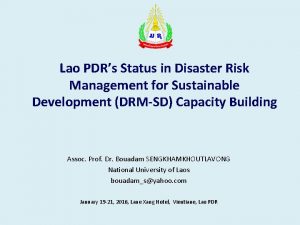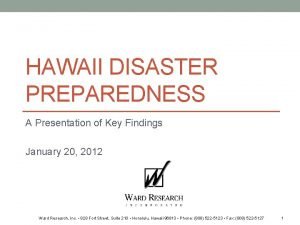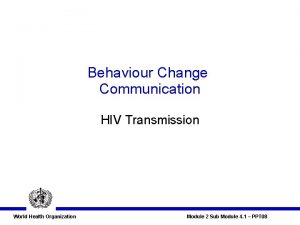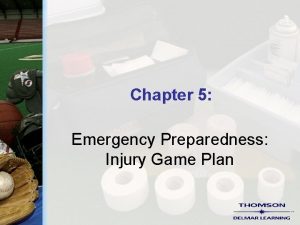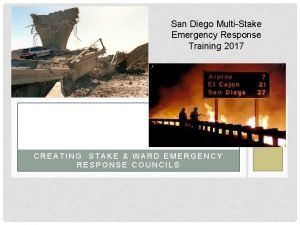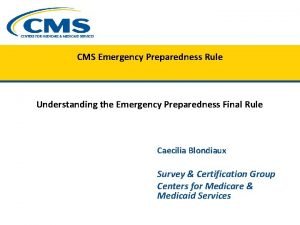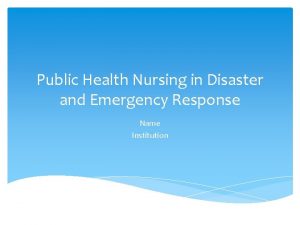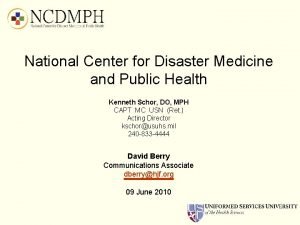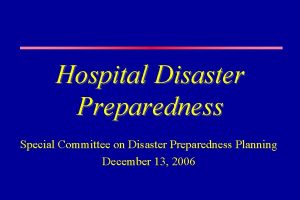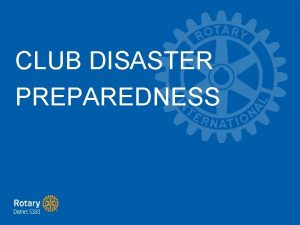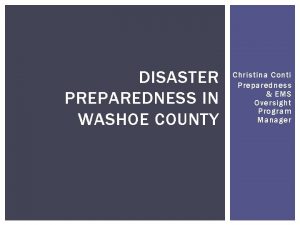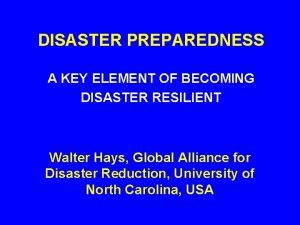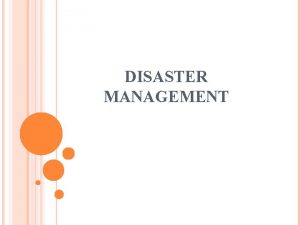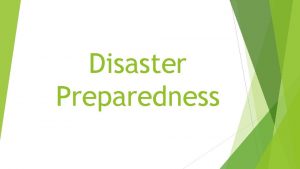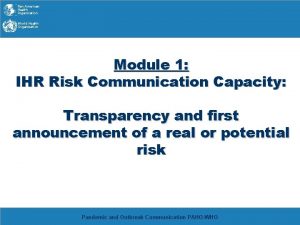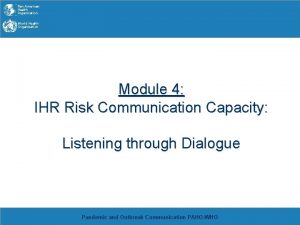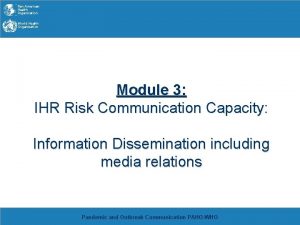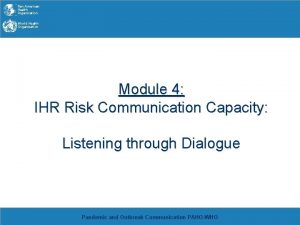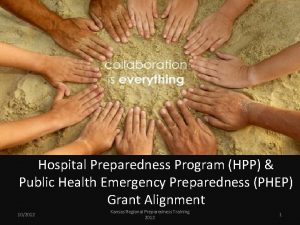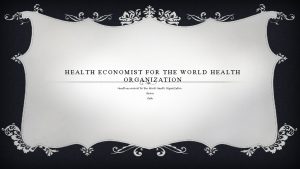Disaster Preparedness DISASTER DEFINITION The World Health Organization






































































- Slides: 70

Disaster Preparedness

DISASTER DEFINITION • The World Health Organization defines a disaster as a sudden ecologic phenomenon of sufficient magnitude to require external assistance. • A disaster is an event that overwhelms the resources of the region or location in which it occurs. • A hospital disaster may be of any size and is not limited to mass casualty incidents. • Whether an event is a disaster further depends on the time of day, nature of the injuries, type of event, and the amount of preparation time before the arrival of patients.

TYPES OF DISASTERS • External disasters occur at locations that are physically separate from the hospital (e. g. , transportation accident, industrial accident). • An internal disaster is an event that occurs within the confines of the hospital (e. g. , bomb scare, laboratory accident involving radiologic agents, power failure). • Disasters can be both internal and external (e. g. , earthquake with mass casualties as well as damage to the internal hospital).

DISASTER PREPAREDNESS AND PLANNING • The general components of the disaster plan include : • hazard vulnerability analysis, • compliance with agency requirements, • hospital–community coordination, • integration with national response assets, and • training and disaster drills.

HOSPITAL EMERGENCY OPERATIONS PLAN • The hospital emergency operations plan provides for an organized response of the hospital from the time of notification of a disaster until the situation normalizes. • Functions include: 1) activation of the emergency operations plan, 2) establishment of an emergency operations center, 3) assessment of hospital capacity, 4) surge capacity planning, 5) communications, 6) supply and resupply, 7) triage and treatment of casualties, 8) establishment of support areas, and 9) termination of the disaster state to allow for recovery and the return to normal activities.

ACTIVATE THE EMERGENCY OPERATIONS PLAN • Clearly delineate the roles and responsibilities of all employees in the ED and any employees who may respond to the ED in the planning process; those roles must be clearly listed and easily accessed in the event of a disaster. • Clarify the reasons for activation of the emergency operations plan. • Activation of the emergency operations plan should provide for the immediate mobilization of supplies, equipment, and personnel.

ESTABLISH EMERGENCY OPERATIONS CENTER • The Incident Command System is a standard emergency management system used to provide a flexible command control structure upon which to organize a response. • there are five main components to the organizational structure: • (1) incident command, • (2) operations, • (3) planning, • (4) logistics, and • (5) finance.

Operations • Disaster emergency operations center within the hospital in a predesignated area {should be able to communicate with the ED and triage area and with external authorities (regional EMS, police, fire, public health agencies)}. • opening up additional hospital wards or clinics, obtaining outside assistance, evacuating endangered patients, assigning staff to treatment areas, and terminating the disaster mode of operation.

ASSESS HOSPITAL CAPACITY • Before the hospital can receive casualties, it must be determined if the hospital itself has sustained any structural damage or loss of use as a result of a disaster. • If the hospital’s structural integrity has been compromised, it may be necessary to initiate the evacuation plan to evacuate staff and patients. • Once it is determined that the hospital itself is safe, the hospital should determine how many casualties from the disaster site it can safely manage. • At the time of disaster notification, it is necessary to know the status of many of the hospital’s capabilities: how many beds are available, how much critical supplies and medications are available, how many personnel are on duty, what damage has been done, how many operating rooms are in use, which clinicians are present in the hospital, and so forth.

CREATE SURGE CAPACITY • Surge capacity is the ability to increase hospital bed capacity over normal limits. • Intrahospital surge may include doubling patients in rooms, converting an acute care ward to an intensive care level unit, opening previously closed wards, or caring for patients in typically nonclinical locations, such as the cafeteria. • Interhospital or regional surge may include discharging hospitalized patients to an external low acuity unit, either mobile or fixed, and altering standards of care (typically a role of the state governor and legislature and only during governor-declared disasters)

ESTABLISH COMMUNICATIONS SYSTEMS • Establishment of good communications is critical in any disaster or mass casualty situation.

SUPPLIES • During a disaster, necessary supplies and equipment must be ready for immediate distribution to appropriate locations in the hospital. • • Each hospital will need to estimate the amount of supplies that will be needed in stock over and above their regular hospital supply. • This logistical issue makes it necessary for most hospitals to rely on their own supplies for a period of at least 96 hours.

ESTABLISH SUPPORT AREAS • Family Information Center • Volunteer Coordination Center • Media Center Identify a single hospital spokesperson to relay information to the media.

DECONTAMINATION, TRIAGE, AND TREATMENT • Certain areas of the hospital must be designated for specific functions, including • decontamination, • triage, • care of major and minor casualties, a) RESUSCITATION b) MINOR TREATMENT AREA • presurgical holding and • surgical triage, (Send trauma patients who are initially stabilized in the ED to the presurgical holding area for preoperative preparation and observation). • psychiatric care, and • morgue facilities.

TERMINATING DISASTER RESPONSE (RECOVERY) • As soon as appropriate, direct efforts toward returning the hospital to normal operations. • Besides restocking and cleaning, give consideration to the emotional stress experienced by both the EMS and hospital staff. • critical incident stress debriefing

FIELD DISASTER RESPONSE • FIELD TRIAGE AND MEDICAL CARE • In the field, rescue personnel often use a simple triage and rapid treatment technique that depends on a rapid assessment of respiratory status, perfusion, hemorrhage control, and mental status. • Patients are then triaged to immediate care, delayed care, or dead/dying

FIELD DISASTER RESPONSE • When patients are likely to have significantly delayed transport from a scene (e. g. , number of casualties exceeds transportation capacity or damage to hospital infrastructure), the “Secondary Assessment of Victim Endpoint” triage system may be helpful to identify patients who are most likely to benefit from the care available under austere field conditions. • Category 1 includes patients who will die regardless of how much care they receive. • Category 2 includes patients who will survive whether or not they receive care. • Category 3 includes patients who will benefit significantly from austere field interventions.

FIELD DISASTER RESPONSE • COMMUNICATION—DISASTER SITE TO HOSPITALS • The local emergency communications or emergency operations center should alert hospitals in the affected area of possible mass/multiple casualty situations or disasters. This report should include the total number of injured, the number of seriously injured (who may need intensive care unit capability), and the number for whom ambulatory treatment is sufficient. • Hospitals should report to the local emergency communications center the following information: bed availability, number of casualties received thus far, number of additional casualties that the hospital is prepared to accept, and specific items in short supply.

FIELD DISASTER RESPONSE • DISTRIBUTION OF CASUALTIES TO RECEIVING HOSPITALS • Maintain good communication between hospitals and on-site EMS command in order to minimize unequal distribution of victims. • Alert the on-scene incident commander immediately of a potentially overloaded hospital. • In this situation, the less injured and more stable can be sent a further distance to outlying hospitals.

FIELD DISASTER RESPONSE • MANAGEMENT OF ON-SITE DISASTER MEDICAL TEAMS FROM HOSPITALS • On-site disaster medical teams dispatched from local hospitals may be of value in situations in which victims require prolonged extrication; transportation routes are blocked, preventing easy evacuation to hospitals; or the number of casualties is of such magnitude that they exceed transportation capacities.

ED DISASTER RESPONSE INITIAL RESPONSE • The ED physician or charge nurse becomes the on-site incident commander until the plandesignated incident commander arrives. Among the decisions to be made are those related to the admission, discharge, or transfer of patients, and decisions about the priority of patient care. • Discharge all nonemergency patients from the ED with responsible individuals.

ED DISASTER RESPONSE INITIAL RESPONSE • Take all available litters and wheelchairs to the ambulance entrance immediately on announcement of the disaster status. Patients from the disaster site are met at the receiving area by hospital escorts who assist the EMTs in transferring patients to wheelchairs or stretchers. • Place essential equipment, such as endotracheal tubes, IV fluids, cervical collars, splints, and bandages, near the ambulance entrance to permit convenient restocking of the ambulance (when plans call for ambulance restocking from hospitals) and rapid return to the disaster site.

SECURITY • Hospital security diverts nonessential vehicles and ensures a smooth, one-way flow of traffic to the ambulance entrance. Once patients, family, and media arrive, security is also responsible for protecting the treatment areas and inhibiting unplanned entry into the hospital.

TRIAGE • Triage will need to be performed at the ED entrance even if it was done at the scene. • Patient care at triage should be limited to manually opening airways and controlling external hemorrhage. • Catastrophically injured patients who have a minimal chance for survival despite optimal medical care should be classified as “expectant” (“black”: to include patients with burns involving 95% body surface area, and patients in full cardiac arrest or septic shock). • The goal with these “expectant” patients should be adequate pain control and the opportunity to be with friends and family.


TRIAGE TEAM • A team consisting of an emergency physician, an ED nurse, and medical records or admitting clerks should receive every patient. • Assign one member of the triage team (admitting or medical records clerk) the job of recording the victim’s name on the disaster tag along with the triage destination within the hospital. • If identification of the patient is not available, ethnicity, gender, and approximate age should be noted on the tag. An initial diagnostic impression should also be registered on the tag.

ED DISASTER PATIENT CARE • Disaster care concepts often vary from the typical ED routine. Care that is not immediately time sensitive can be provided the next day. • In the event of prolonged extrication from rubble, assess for delayed signs and symptoms, including cardiac dysrhythmias, hyperkalemia from crush injury, renal failure, and pulmonary blast injury. • Use radiographic and laboratory studies sparingly, if at all, in a mass casualty situation, and only if the results of such tests will change treatment. • CT imaging may be quicker than plain radiographs in some injuries, and prioritization to CT may be required.

ED DISASTER PATIENT CARE • With the exception of identification of biological and chemical agents, there are few indications for laboratory testing in disaster medicine. • Consider laboratory studies to be accessory and ordered only in specific circumstances (carboxyhemoglobin in cases of smoke inhalation). • In a disaster situation involving many casualties, the blood bank should have up to 50 units of blood available and should have access to volunteer donors who can be rapidly mobilized. Potential donors include friends and family members of patients, as well as mildly injured patients.

Natural Disasters

DISEASE BURDEN • Common medical problems after natural disasters include traumatic injury, infectious disease, exacerbations of chronic medical conditions, and a surge in mental health issues

TRAUMA • Traumatic injuries frequently occur in the acute phase of a natural disaster, commonly from direct trauma from collapsing structures or flying debris. A second spike in trauma is seen during the recovery/clean-up phase, mainly due to unsafe infrastructure. • This necessitates adequate resources of anesthesia, blood products, surgical equipment and the ability to sterilize it, intensive care capacity, and operating theaters. • Recommendations for adequate surgical capability include mobile blood banks with adequate supply and well-trained staff, at least two units of blood available per operation, adequate supplies of appropriate anesthesia, strict adherence to national or international quality and safety standards, and functioning critical care units.

INFECTIOUS DISEASE • Although popular media often focuses on the possibility of rare disease epidemics, most postdisaster infections are directly related to the usual pathogens of that region. • Evidence indicates that the combination of communicable disease and population malnutrition is the major cause of morbidity and mortality in most disasters. • Infectious disease risks are heightened by certain characteristics common to natural disasters: mass population movement and resettlement; overcrowding; poverty; sanitation and waste issues, including water contamination; absence of shelter, food, and healthcare access; and disruption of public health programs. Respiratory, GI, skin/soft tissue, and vectorborne infectious diseases are most commonly analyzed in disasters.

INFECTIOUS DISEASE • Some respiratory illnesses (pertussis and measles) are preventable with adequate vaccination; thus, knowledge of the predisaster vaccination status of a population and sufficient vaccine stores may prevent severe outbreaks. • organisms such as Vibrio vulnificus in waterbased disasters and gram-negative bacteria due to soil contamination of wounds in tornadoes and earthquakes have the potential for severe threats to life and limb. • Although rare, the outbreak can occur up to 8 weeks after disaster. • In regions where these illnesses are endemic, vector control is key, and initial postdisaster public health efforts should direct resources toward appropriate programs.

CHRONIC MEDICAL CONDITIONS • Inability to properly control chronic diseases, such as hypertension, diabetes, asthma, or coronary artery disease, may well be the biggest unanticipated health threat to a postdisaster population

MENTAL HEALTH • Any appropriate healthcare response to disasters must include sufficient resources to deal with the degree and severity of psychological disorders suffered by survivors, including children, first responders, and those who have endured severe trauma or loss.

HANDLING OF BODIES • Universal precautions for protective coverings, hand washing, disposal bags, and vaccinations should be followed by anyone working with dead bodies; this includes having sufficient refrigerated trucks on standby should morgue capabilities be overwhelmed.

HURRICANES • Indeed, hurricanes may be the only natural disaster where more injury and death occur during the recovery period than in the acute phase • Initial traumatic injury directly due to hurricanes is relatively uncommon, and simple supplies for minor sprain, strain, and fracture care recommended.

RELIEF EFFORTS • The National Disaster Medical System, a government agency responsible for sending highly organized and often experienced teams to disaster areas, recommends the following for disaster response: teams with well-trained and organized support staff; the ability to be selfsufficient for at least 72 hours; clear communication with area hospitals and medical resources; individuals dedicated to transportation issues; adesignated coordinator of walk-in volunteers; and professional methods of record keeping, forms, and copy-making capability.

Bomb, Blast, and Crush Injuries

Identification • An explosion is the instantaneous transformation of a solid or liquid into a gas, releasing tremendous kinetic and heat energy.

BLAST INJURIES • There are four main types of blast effects. • A primary injury is caused by a direct effect of blast wave overpressure on tissue. Primary blast injury mostly (but not exclusively) affects air-filled structures such as the lungs, ears, and GI tract, by the following mechanisms: spalling, shearing, and implosion. • An example is a blast wave causing the lung parenchyma to explode into the alveolar space like a geyser.

BLAST INJURIES • A secondary blast injury is due to collateral damage from flying objects and shrapnel. • Tertiary blast injury results from the victim being propelled through the air and striking stationary objects. • A quaternary blast injury is a result of burns, smoke inhalation, or chemical agent release.

FACTORS AFFECTING BLAST INJURY • • • Distance of victim from explosion Enclosed versus open space Surrounding environment Quantity of explosive Type of explosive loworder or high-order. Embedded shrapnel

CLINICAL FEATURES

CARDIOPULMONARY SYSTEM • The lung is very susceptible to primary blast injury. Pulmonary barotrauma is the most common fatal primary blast injury and the most common critical injury in people close to the blast center. • In general, managing blast lung injury is similar to caring for pulmonary contusion and acute respiratory distress syndrome. • In general, asymptomatic patients with normal chest radiographs and normal room-air pulse oximetry may be considered for discharge after 4 to 6 hours of observation as long as there is no clinical deterioration.

CARDIOPULMONARY SYSTEM • Keep tidal volume to 6 to 7 m. L/kg ideal body weight to limit the peak inspiratory pressure and to minimize ventilator-induced lung barotrauma. Often, neuromuscular paralysis and early institution of pressure-limited ventilation (plateau pressures <30 cm H 2 O), with the lowest pressures compatible with adequate ventilation, may be the best strategy. • Inverse inspiratory-to-expiratory ratio ventilation may be useful. • Permissive hypercapnia is acceptable depending on cerebral perfusion pressure or increased intracranial pressure. 13 Aggressive methods of oxygenation, such as extracorporeal membrane oxygenation or intravascular oxygenation, may become necessary within hours of the injury.

EARS • Patients with an isolated tympanic membrane perforation and no other immediately identified injuries should have a chest radiograph ordered but do not automatically require an extended period of observation. • Conversely, intact tympanic membranes do not imply the absence of serious injury, and the use of the perforation of tympanic membrane as an indicator of primary blast injury missed up to 50% of those suffering a primary blast injury to the lung. • Clinical judgment is necessary, and limited observation is reasonable for patients with intact tympanic membranes.

ABDOMEN • A review of the literature on abdominal trauma from primary blast injury reveals an incidence of 1. 3% to 33%, and the terminal ileum and cecum were the most commonly injured areas. • Serial clinical examinations, serial imaging as needed, and 24 - to 48 -hour observation are indicated whenever the suspicion arises. • Air is a poor conductor of blast-wave energy; thus, patients who were subjected to enough energy to damage abdominal organs probably were situated near the explosive device.

VASCULAR INJURY • Carefully assess and document pulses and perfusion in affected limbs. Observe for delayed presentation of compartment syndrome, and measure compartment pressure if any signs or symptoms develop. Early angiography and intervention are indicated if pulses are lost.

EXTERNAL HEMORRHAGE • Military experience has shown that hemorrhage is the most common cause of preventable death in penetrating trauma. • Apply tourniquets for extremity hemorrhage whenever blood loss cannot be controlled with direct pressure, or if the resources required to maintain direct pressure are insufficient during either treatment or transportation. • Tourniquets have been successfully used for up to 6 hours in battlefield situations.

OCULAR INJURIES • Ocular injuries include lid or brow lacerations, conjunctival lacerations, open globe injuries, orbital fractures, retinal detachment, retained intraocular foreign body, lens dislocation, vitreous hemorrhage, retinal tears and retinal detachment. • Eye examination is needed for all moderately to severely injured blast victims, and a poor initial visual acuity is not a guarantee of a poor final result.

DIAGNOSIS • Plain chest radiographs, ultrasonography, and diagnostic peritoneal lavage are the most rapid studies used to evaluate for lifethreatening injuries. Order laboratory tests sparingly.

TREATMENT • Checklists should be concise, never more than one to two pages, and available in a location known to everyone. Implement the hospital plan for management of mass casualty incidents. • The nature and location of the blast, including size and type of charge, location in open or closed space, structural collapse, associated fire or smoke, and toxic agent release, will be helpful in making informed clinical decisions, especially with regard to disposition of moderately to severely injured casualties.

Triage

TREATMENT • Activated factor VII administration or tranexamic acid may be considered in select cases of uncontrollable bleeding. • Copiously irrigate and disinfect wounds urgently, but definitive debridement and closure may wait a few hours. • Temporary splinting, traction, and dressings are generally sufficient for initial management of musculoskeletal injuries. • Consider prophylactic antibiotics for severely soiled wounds, penetrating abdominal and thoracic wounds, and open fractures, and in patients with diabetes or who are immunocompromised.


Discharge • Because symptoms of pulmonary contusion and intestinal hematoma may take 12 to 48 hours to develop, instruct all discharged patients to return for reevaluation if they develop breathing problems, abdominal pain, or vomiting. • Provide relevant follow-up instructions in writing, including audiologic and ear, nose, and throat follow-up, wound care, immunization schedules, medications, psychological support, and social services.

PREGNANT WOMEN • Injuries to the placenta, however, are more common. • After life-threatening conditions have been stabilized, admit patients in the second or third trimester of pregnancy who have been exposed to blast injury to the labor and delivery area for continuous fetal monitoring and further testing and evaluation. • Pelvic US, fetal nonstress test monitoring, and obstetrics consultation should always be obtained. • Consider Rh immune globulin administration if the mother’s blood type is Rh negative.

CHILDREN • Children may suffer significant tertiary blast injury because their lighter bodies are more easily hurled by the blast wind. • Imaging, such as totalbody CT, may be difficult to perform in anxious and frightened children. Children typically require sedation to facilitate imaging.

STAFF SAFETY • Issues that may affect staff safety include: • (1) possible infiltration of the ED by perpetrators intent on causing second explosions or attacks in the hospital; • (2) unexploded explosives inadvertently brought into the ED; • (3) transmissible disease in the setting of body fluid exposure or needle sticks during stressful, rapid work; • (4) contamination of victims by chemical, radiologic, and biologic hazards, either accidental or intentionally caused by the perpetrators.

INFORMATION MANAGEMENT • information concerns include: • (1) clinical charting and other patient care– centered information, such as imaging; • (2) command control information, such as casualty flow data, resource management data, and interface with other agencies; • (3) information provided to relatives; • (4) information provided to the media; • (5) information recorded for quality improvement and research.

CRUSH INJURY AND THE CRUSH SYNDROME

• A crush injury occurs when a body part is subjected to a high degree of force or pressure, usually after being squeezed between two heavy or immobile objects. Crush injury that produces ongoing ischemia of a fascial muscle compartment is termed compartment syndrome, defined as increased pressure within a confined space that leads to microvascular compromise and ultimately to cell death as a result of oxygen starvation. • Crush injuries are most commonly seen in the extremities, because crush of the trunk or head and neck is quickly lethal. • Crush syndrome is the systemic manifestation of muscle cell damage resulting from pressure or crushing with or without subsequent compartment syndrome.

PATHOPHYSIOLOGY • Hyperkalemia and hypocalcemia may cause arrhythmias and cardiac arrest. • Metabolic acidosis caused by hypovolemia and shock aggravates arrhythmogenicity. • Renal failure is the most serious complication of crush syndrome. • The inflammatory response has both local and systemic manifestations. Systemic manifestations include hypotension, vasodilatation, hypovolemia, myocardial depression, hyperkalemia, and acidosis. • Normal muscle compartment pressure is <10 mm Hg. Pressures >30 mm Hg produce muscle ischemia; irreversible nerve and muscle damage occurs after 4 to 6 hours.

CLINICAL FEATURES • Compartment syndrome often presents with the five “P’s”: pain, paresthesias, passive stretch, pressure, and pulselessness. • Pain is the most common and consistent symptom, described as diffuse and intense; exacerbated with movement, touch, or pressure; and out of proportion to physical examination findings.

CLINICAL FEATURES • Crush syndrome is due to the manifestations of muscle toxin release and hypovolemia. • Hypovolemic shock may occur, aggravated by hyperkalemic, hypocalcemic, or acidemic cardiotoxicity. • Thromboplastin release may cause disseminated intravascular coagulation, which is especially critical in the face of tissue damage, open wounds, or the needfor surgery. • Renal failure may ensue quickly and is the primary cause of delayed death.

DIAGNOSIS • Testing of the compartment pressure will confirm the diagnosis. A compartment pressure of >30 mm Hg is considered to be a positive test. • Crush syndrome is characterized by protean and rapid metabolic changes. Laboratory tests are crucial to help direct management. • Serum creatine kinase levels may not necessarily predict disease severity and risk of renal failure, but they are a useful initial triage and subsequent followup tool. • Pay close attention to serum potassium, calcium, phosphorus, p. H, creatinine, hemoglobin, coagulation indices, and urine p. H and electrolytes. • A preplanned sequence of laboratory tests every 2 to 4 hours is useful, rather than sporadic checks. Urine collection for total electrolyte excretion and creatinine clearance calculations may be considered

TREATMENT • Establish two large-bore IV lines and administer normal saline with a 1 - to 2 -L bolus. • Avoid Ringer’s lactate and other potassium-containing fluids, because fatal hyperkalemia may occur, even in the absence of renal failure. • Initiate IV fluid rate at 1000 m. L/h, and then reduce to 500 m. L/h after 2 hours. • Urine output should be approximately 200 to 300 m. L/h (5 to 7 L every 24 hours) for an adult. Monitor serial serum potassium levels. • Admit the patient to an intensive care unit setting to monitor fluid administration and electrolyte status.

FASCIOTOMY • Most recommendations discourage the use of routine fasciotomy, particularly for crush wounds, and fasciotomy is only indicated for absence of distal pulses, a requirement for debridement of necrotic muscle, compartment pressures >30 mm Hg (measured within 6 hours of injury), and differences between compartmental pressure and diastolic blood pressure of >30 mm Hg. • If initial compartment pressures are normal and delayed compartment syndrome develops, fasciotomy may be needed, but infection rates have been reported to be high and prolonged, and profuse local bleeding may develop.

HYPERBARIC OXYGEN THERAPY • The immediate effects of hyperbaric oxygen therapy are threefold: • enhanced oxygen at the tissue level, • increased oxygen delivery per unit of blood flow, and • edema reduction. • Long-term effects may include improved wound repair after fasciotomy, diminished infection rates, and improved outcome of skin grafts.
 Conclusion about disaster management
Conclusion about disaster management Hawaii disaster preparedness
Hawaii disaster preparedness Health promotion and maintenance
Health promotion and maintenance Wahis oie
Wahis oie World health organization growth charts
World health organization growth charts World health organization
World health organization World health organization photos
World health organization photos Elements of observational learning
Elements of observational learning Shelby county office of preparedness
Shelby county office of preparedness Biological preparedness
Biological preparedness Conditioning learning
Conditioning learning Preparedness mitigation response recovery
Preparedness mitigation response recovery Biological preparedness
Biological preparedness Do. 27 s. 2015 promoting family earthquake preparedness
Do. 27 s. 2015 promoting family earthquake preparedness Data breach preparedness
Data breach preparedness Operant conditioning
Operant conditioning Chapter 5 emergency preparedness injury game plan
Chapter 5 emergency preparedness injury game plan Chapter 36 emergency preparedness and protective practices
Chapter 36 emergency preparedness and protective practices Bsa emergency preparedness
Bsa emergency preparedness West virginia center for threat preparedness
West virginia center for threat preparedness National radiological emergency preparedness conference
National radiological emergency preparedness conference Chapter 36 emergency preparedness and protective practices
Chapter 36 emergency preparedness and protective practices Stake emergency preparedness plan
Stake emergency preparedness plan Pip framework
Pip framework Nfpa 1600
Nfpa 1600 What are disasters
What are disasters Nfpa business continuity
Nfpa business continuity Cms emergency preparedness rule
Cms emergency preparedness rule Process organization in computer organization
Process organization in computer organization Organization by point
Organization by point Role of public health nurse in disaster response
Role of public health nurse in disaster response National center for disaster medicine and public health
National center for disaster medicine and public health Hình ảnh bộ gõ cơ thể búng tay
Hình ảnh bộ gõ cơ thể búng tay Ng-html
Ng-html Bổ thể
Bổ thể Tỉ lệ cơ thể trẻ em
Tỉ lệ cơ thể trẻ em Chó sói
Chó sói Tư thế worms-breton
Tư thế worms-breton Hát lên người ơi
Hát lên người ơi Các môn thể thao bắt đầu bằng tiếng bóng
Các môn thể thao bắt đầu bằng tiếng bóng Thế nào là hệ số cao nhất
Thế nào là hệ số cao nhất Các châu lục và đại dương trên thế giới
Các châu lục và đại dương trên thế giới Công thức tiính động năng
Công thức tiính động năng Trời xanh đây là của chúng ta thể thơ
Trời xanh đây là của chúng ta thể thơ Cách giải mật thư tọa độ
Cách giải mật thư tọa độ Làm thế nào để 102-1=99
Làm thế nào để 102-1=99 độ dài liên kết
độ dài liên kết Các châu lục và đại dương trên thế giới
Các châu lục và đại dương trên thế giới Thể thơ truyền thống
Thể thơ truyền thống Quá trình desamine hóa có thể tạo ra
Quá trình desamine hóa có thể tạo ra Một số thể thơ truyền thống
Một số thể thơ truyền thống Cái miệng bé xinh thế chỉ nói điều hay thôi
Cái miệng bé xinh thế chỉ nói điều hay thôi Vẽ hình chiếu vuông góc của vật thể sau
Vẽ hình chiếu vuông góc của vật thể sau Thế nào là sự mỏi cơ
Thế nào là sự mỏi cơ đặc điểm cơ thể của người tối cổ
đặc điểm cơ thể của người tối cổ Thế nào là giọng cùng tên?
Thế nào là giọng cùng tên? Vẽ hình chiếu đứng bằng cạnh của vật thể
Vẽ hình chiếu đứng bằng cạnh của vật thể Vẽ hình chiếu vuông góc của vật thể sau
Vẽ hình chiếu vuông góc của vật thể sau Thẻ vin
Thẻ vin đại từ thay thế
đại từ thay thế điện thế nghỉ
điện thế nghỉ Tư thế ngồi viết
Tư thế ngồi viết Diễn thế sinh thái là
Diễn thế sinh thái là Các loại đột biến cấu trúc nhiễm sắc thể
Các loại đột biến cấu trúc nhiễm sắc thể Số nguyên tố là gì
Số nguyên tố là gì Tư thế ngồi viết
Tư thế ngồi viết Lời thề hippocrates
Lời thề hippocrates Thiếu nhi thế giới liên hoan
Thiếu nhi thế giới liên hoan ưu thế lai là gì
ưu thế lai là gì Sự nuôi và dạy con của hổ
Sự nuôi và dạy con của hổ Khi nào hổ con có thể sống độc lập
Khi nào hổ con có thể sống độc lập
